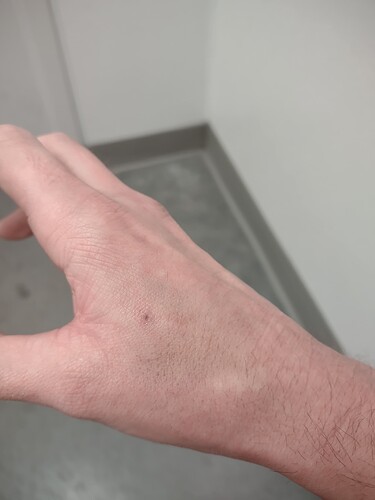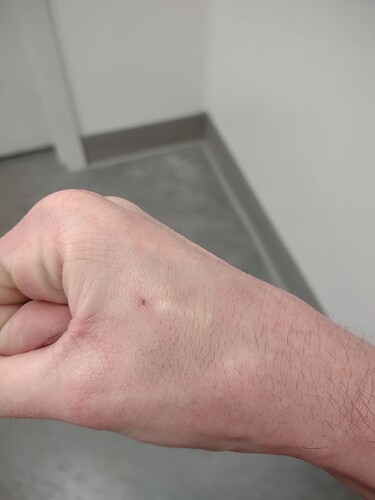For me, swelling peaks the day after. I’ve also never failed to get a read.
I’m lucky like that too: no swelling - immediate reads.
Then again, I snore, can’t keep fat off my belly and I’m allergic to cats so you get what you get in the genetic lottery.
Still able to read it from the proxmark this morning. ![]()
And I was able to write my contact info to the NTAG as well.
Quick update, been a week and 3 days now.
Pretty much healed up, very small amount of bruising. Still looking good. ![]()
Looks textbook ![]()
Now what are you going to do with it?
And what’s next?
The goal is to not have to carry keys!
Planning on wiring in an RFID reader to unlock my car, as well as an RFID ignition system.
Door locks for the house.
And I also plan on buying my first motorcycle in hopefully the near future, so I want to be able to go keyless on that too!
Also trying to work out replacing my work badge to get through the doors with my implant.
Will likely end up storing some sensitive data on it too, like offline Google 2fa codes, MAYBE a PGP key if I can fit one.
What car? There are a few common ways. Directly to lock cylinder, to the door button, to a spare remote.
Sounds like an Apex/Flexsecure might be in your future. ![]()
Currently an 03 Toyota Highlander. I’ve given a lot of though to unlocking. Ill probably wire to my remote, I only have the one, but the keychain part is broken so I never carry it, plus I wouldn’t need to anyway with the RFID unlock. I’ve thought about having 2 readers as well, one for lock and one for unlock. Also thought about wiring in a reserve battery for the readers, and just having the car charge the reserve battery when it’s on so I don’t have to worry about battery drain. Still have a lot to figure out before I commit to the reserve battery idea.
Oh I’ve been looking!
What I ended up doing on my 2010 Mazda 6 is wiring the relay to the actual locking cylinder, when scanned it unlocks all the doors. I initially used the unlock button itself, but the car automatically disabled the unlock button after X minutes of being locked.
Converting the ignition was a little farther than I wanted to go, so I simply hide the keyfob inside the car and lock using the button on the door when I exit. Drain isn’t really an issue, I calculated I would have to leave my car untouched for a bit over a month to drain it a worrying amount.
It’s usually desirable to have two keyfobs if you wire the relay to a fob itself (unless you rig up the ignition as well). But there are little DC-DC converters for 12v to 3.3v or whatever the fob uses.


